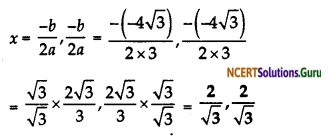These NCERT Solutions for Class 10 Maths Chapter Ex 4.4 Questions and Answers are prepared by our highly skilled subject experts.
NCERT Solutions for Class 10 Maths Chapter 4 Quadratic Equations Exercise 4.4
![]()
Question 1.
Find the nature of the roots of the following quadratic equations. If the real roots exist, find them:
(i) 2x² – 3x + 5 = 0
(ii) 3x2 – 4√3x + 4 = 0
(iii) 2x2-6x + 3 = 0
Solution:
(i) We have,
2x² – 3x + 5 = 0
Here, a = 2, b = – 3 and c = 5
∴ Discriminant (D) = b² – 4ac = (- 3)² – 4 x 2 x 5 = 9 – 40 = – 31
∴ D= – 31
Here, discriminant (D) < 0 Therefore, the given quadratic equation has no real roots.
(ii) We have, 3x² – 4\(\sqrt{3x}\) + 4 = 0
Here, a = 3, b= – 4\(\sqrt{3x}\) and c = 4
∴ Discriminant (D) = b² – 4ac = \((-4 \sqrt{3 x})^{2}\) x 4 = 48 – 48
∴ Discriminant (D) = 0
Therefore, the given quadratic equation has two equal real roots.

(iii) We have, 2x² – 6x + 3 = 0
Here, a = 2,b = – 6, c = 3
∴ Discriminant (D) = b² – 4ac = (- 6)2 – 4 x 2 x 3 = 36 – 24 = 12
∴ D= 12 Discriminant (D) > 0
Therefore, the given quadratic equation has two distinct real roots. Distinct roots \(\sqrt{3x}\)
![]()
Question 2.
Find the value of k for each of the following quadratic equations, so that they have two real equal roots.
(i) 2x² + kx + 3 = 0
(ii) kx(x – 2) + 6 = 0
Solution:
(i) We have,
2x² + kx + 3 = 0
Here, a = 2, b = k and c = 3
∴ Discriminant (D) = b² – 4ac = k² – 4 x 2 x 3
D = k² – 24
But we have given that equation has two real and equal roots.
∴ D = 0
k² – 24 = 0
k² = 24
∴ k = \(\sqrt{24}\)
k = ±2\(\sqrt{6}\)
(ii) We have,
kx (x – 2) + 6 = 0
or, kx² – 2kx + 6 = 0
Here, a = k, b = – 2k and c = 6
∴ Discriminant (D) = b²- 4ac
= (- 2k)² – 4 x k x 6
D= 4k² – 24k
But we have given that equation has two real equal roots.
∴ D = 0
4k² – 24k = 0
or, 4k(k – 6) = 0
So, 4k = 0 or k – 6 = 0
Therefore, k = 0 or k = 6
![]()
Question 3.
Is it possible to design a rectangular mango grove whose length is twice its breadth and the area is 800m2 ? If so, find its length and breadth.
Solution:
Let breadth of rectangular mango grove = x
∴ length of rectangular mago grove = 2x
∴ Area of rectangular mango grove = l x b
or 800 = x × 2x [∴ Area of rectangle = Length x Breadth]
or 800 = 2x²
or x = \(\frac { 800 }{ 2 }\)
∴ x = \(\sqrt{400}\) = ± 20
Since, dimensions cannot be in negative, so we reject the value of x = – 20.
∴ Breadth of rectangular mango grove = x = 20 m
and length of rectangular mango grove = 2x – 2 x 20 = 40m
![]()
Question 4.
Is the following situation possible? If so, determine their present ages. The sum of the ages of two friends is 20 years. Four years ago, the product of their ages in years was 48.
Solution:
Let the present age of one friend be x
∴ the present age of other friend be 20 – x
Four years ago age of first friend = x – 4
and four years ago age of second friend = (20 – x) – 4 = 16 – x
∴ According to question,
(x – 4) (16 – x) = 48
or 16x – x² – 64 + 4x = 48
or – x² + 20x – 64 = 48
or x² – 20x + 64 + 48 = 0
or x² – 20x + 112 = 0
Here, a 1,b = -20 and c = 112
∴ Discriminant (D) b² – 4ac
= (-20)2 – 4 x 1 x 112
= 440 – 448 = -48
∴ D<0
So, the equation has no any real roots.
Therefore, the given situation is not possible.
![]()
Question 5.
It is possible to design a rectangulat park of perimeter 80 m and area 400 m²? If so find its length and breadth.
Solution:
Let the length of the rectangular park = x
∴ the breadth of the rectangular park = (40 – x)
∴ Area of rectangular park = Length x Breadth
or 400 = x(40 – x)
or 400 = 40x – x²
or x² – 40x + 400 = 0
Here, a = 1, b = -40 and c = 400
∴ Discriminant (D) = b² – 4ac
= (- 40)² – 4 x 1 x 400
= 1600 – 1600
D = 0
Therefore, equation has two real and equal roots.
\(\begin{aligned}
x &=\frac{-b \pm \sqrt{b^{2}-4 a c}}{2 a} \\
&=\frac{-(-40) \pm \sqrt{0}}{2 \times 1}=\frac{40}{2}=20
\end{aligned}\)
So, the length of rectangular park = x = 20 m
and the breadth of rectangular park = (40 -x)
= 40 – 20 = 20 m.
![]()